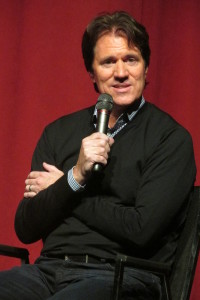Susan’s The Script Lab article
Director Rob Marshall Speaks about Into the Woods,
Themes and Adapting to the Screen
DIRECTOR ROB MARSHALL (Photo credit Tatiana Kouguell-Hoell)
At the Jacob Burns Film Center on December 4, Edie Demas, Executive Director of the JBFC, spoke with director Rob Marshall after the screening of his new film Into the Woods, which was adapted from the musical by Stephen Sondheim and James Lapine, screenplay by James Lapine. “Film is a different pace than theater,” Marshall stated. “The song is the scene.
The 16-minute long opening song establishes the language of how the story will be told.” (Advice for screenwriters: Whatever genre you are writing in, your opening pages not only need to grab the reader’s attention, but it needs to set the tone of the script.) Reimagining the Original Play and Cutting Adapting a beloved theatrical musical to a film musical meant making some challenging choices for Marshall, who praised Lapine and Sondheim for being so open and flexible about making some changes for the film adaptation from the staged musical. “We needed to reimagine the play for the film.” Knowing that they had to get the film down to about two hours, Marshall stated, “The three of us, Sondheim, Lapine, and I, knew we needed to eliminate the musical reprises.” Citing the example of the Cinderella number in the theatrical version with Cinderella’s shoe stuck on stage, “In the play, the action happens off screen.” Marshall humbly continued, “I asked Sondheim, could you adjust the lyrics so it takes place in the moment, like an internal monologue. And he did.” Emphasizing the importance of making the difficult decisions to cut some numbers from the original musical, Marshall underscored the mantra: Serve the film. This is the mantra screenwriters should always keep in the back of their minds as they write: serve your story. Cutting scenes for the greater good — will, in the end, benefit the project. Themes Marshall stated that the central theme of the film is ‘No one is alone.’ “Sondheim said the first half of the piece is about the individual; getting your wish at any cost. The second half is about a community coming together. There are also parent/child themes. You see how the baker is concerned with being a good father, because he didn’t have a good father, he had a father who abandoned him. He’s dealing with that issue; you see that he becomes a good father with Jack. He has to comfort him and help him. With the Witch and Rapunzel relationship — the witch’s mother punished her with ugliness and the witch thinks she’s protecting her child by keeping her in the tower. It says a lot about parent/child relations. The last song reflects this: ‘Children will listen, children will see and learn;’ there are so many layers to the piece.” The Fairy Tale Examined Marshall described Into the Woods as “a fairy tale for the 21st century; it raises important issues for today.” Discussing an example of this, Marshall referred to the character of Cinderella: “She chooses to go back home.cBack to the abuse. You go back to what you know. So that’s what was used.” Further discussing the original version of the Grimm Fairy Tale, Marshall continued: Grimm is a very cautionary tale, not just a happily ever after. We see what follows happily ever after.cThere are consequences to your actions. In the end, we see how the face of the classic family has changed so much. We see this lovely family that you never imagined would be together.” READ MORE  Photo: Disney #intothewoods #robmarshall
Photo: Disney #intothewoods #robmarshall
